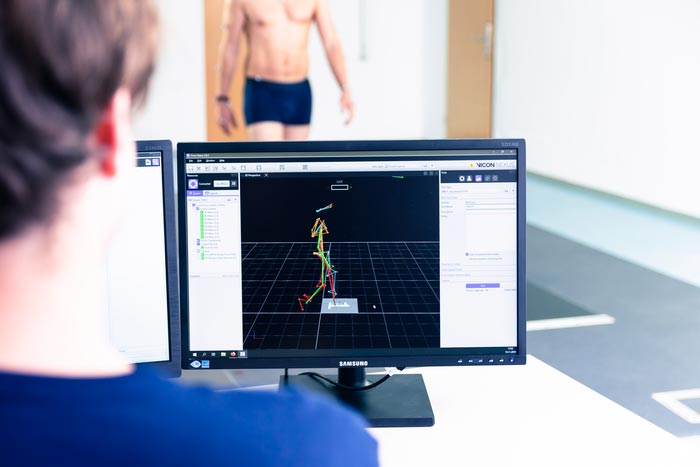World’s largest collection of gait analysis data of healthy individuals published

Biomechanical gait analysis
Photo/©: Florian Kibler, St. Pölten University of Applied Sciences
The Gutenberg Gait Database:
Publicly accessible database provides a reference set of data to be used for the diagnosis and treatment of gait disorders / Further expansion of the database is planned.
Gait disorders manifest themselves in various ways: One walks with small tripping steps, another drags a leg while walking. In one case, a foot does not roll over the sole of the foot, and in another, a foot is not lifted sufficiently but is rather dragged across the floor. For those affected, these disorders may simply have a minor negative impact on their daily routine while for others they can represent a major impairment of their quality of life. In many cases, however, pathological gait patterns are actually accompanying effects or can even be symptomatic of an underlying disease.
For this reason, biomechanical gait analysis can be a helpful tool when it comes to diagnosing problems and subsequently treating them. “Until now, there has been a worldwide lack of reference data for healthy persons,” emphasized Dr. Fabian Horst of Johannes Gutenberg University Mainz (JGU). An adequate quantity of data on the walking characteristics of healthy individuals is needed to be able to reliably detect and classify pathological gait patterns and any causative ailments. Dr. Fabian Horst, a sports scientist, has now presented a database that will help to close this gap. The Gutenberg Gait Database is the world’s largest publicly accessible database containing relevant information on healthy volunteers.
Providing data from 350 healthy individuals aged 11 to 64 years
The database has been compiled by Dr. Fabian Horst of the Institute of Sports Science at Mainz University and Djordje Slijepčević of St. Pölten University of Applied Sciences in Austria and comprises data from 350 healthy volunteers who attended the biomechanics lab at JGU over the past seven years. The database contains ground reaction force (GRF) and center of pressure (COP) data measured for two consecutive steps, which were recorded by force plates embedded in the ground over the entire duration of ground contact of the feet. “GRF is the force exerted by the feet on the ground during contact – it is a standard parameter used throughout the world for the biomechanical analysis of gait,” explained Horst. COP provides additional information on force progression while the progression curve combined with the data on contact force represents an important indicator with regard to interpreting gait patterns.
For their new database, the researchers put together the results of 350 participants aged 11 to 64 years. “Our data originated from ten individual studies, so the (pre-)processing of the measured data had to be standardized before we could merge it,” Horst added.
Gutenberg Gait Database now available to all interested users
Currently the world’s largest database of healthy individuals, the Gutenberg Gait Database is now publicly accessible and can be used for different aims. “Orthopedic institutes, for example, can download the data in order to prepare charts of normative values for use in clinical practice, while research organizations can gain new insights into human gait,” said Slijepčević, outlining some possible applications. The database provides users with both unprocessed raw data and processed ready-to-use data. “These data records offer new possibilities for future studies on human gait, e.g., the application as a reference set for the analysis of pathological gait patterns, or for automatic classification using machine learning,” write the authors in their article in Scientific Data.
Another feature of the database is that it can be used in combination with GaitRec, the largest dataset of pathological gait patterns. “Combining these two data sources enables the development of more complex and robust algorithms for the automatic analysis of gait patterns,” confirmed Slijepčević.
The plan is to continually update the database in future. “The information we have collated to date is mainly that of younger persons. It would be desirable to have a more extensive and balanced database with regard to age and other factors,” concluded Dr. Fabian Horst from the Training and Movement Science division at the JGU Institute of Sports Science.
Related links:
https://springernature.figshare.com/collections/Gutenberg_Gait_Database_A_ground_reaction_force_database_of_level_overground_walking_in_healthy_individuals/5311538/1 – Gutenberg Gait Database ;
https://research.fhstp.ac.at/en/projects/intelligait-3d-gait-data-mining – IntelliGait 3D – Gait Data Mining ;
https://www.nature.com/articles/s41597-020-0481-z – “GaitRec, a large-scale ground reaction force dataset of healthy and impaired gait” (Scientific Data, 12 May 2020)
Journal: Scientific Data
DOI: 10.1038/s41597-021-01014-6
Article Title: Gutenberg Gait Database, a ground reaction force database of level overground walking in healthy individuals
Article Publication Date: 2-Sep-2021
All latest news from the category: Communications Media
Engineering and research-driven innovations in the field of communications are addressed here, in addition to business developments in the field of media-wide communications.
innovations-report offers informative reports and articles related to interactive media, media management, digital television, E-business, online advertising and information and communications technologies.
Newest articles

Innovative 3D printed scaffolds offer new hope for bone healing
Researchers at the Institute for Bioengineering of Catalonia have developed novel 3D printed PLA-CaP scaffolds that promote blood vessel formation, ensuring better healing and regeneration of bone tissue. Bone is…

The surprising role of gut infection in Alzheimer’s disease
ASU- and Banner Alzheimer’s Institute-led study implicates link between a common virus and the disease, which travels from the gut to the brain and may be a target for antiviral…

Molecular gardening: New enzymes discovered for protein modification pruning
How deubiquitinases USP53 and USP54 cleave long polyubiquitin chains and how the former is linked to liver disease in children. Deubiquitinases (DUBs) are enzymes used by cells to trim protein…



